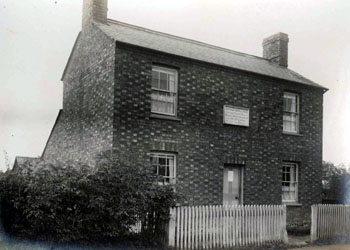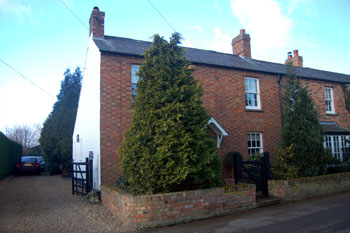The Old Leathern Bottle Beerhouse Cople

Old Leathern Bottle about 1925 [WL800/1]
Old Leathern Bottle, more usually known simply as a no sign beerhouse: 11 Water End, Cople
A beerhouse existed at Water End in Cople from 1852 according to the 1876 Return of Licensed Premises [and confirmed by Constable Gaylor in the Petty Sessions case detailed below]. It was built by William Skilliter on land belonging to the Trustees of the Bunyan Meeting, Bedford, and licensed to sell beer for consumption off the premises. William had been born in Old Warden and at the time of the 1851 census was living with two brothers and a sister in Cople, the eldest brother and William being shoemakers. By 1861 he had married and he and his wife, Ann, a shoe binder, had three children listed at home—three more in 1871, with one more, Arthur, appearing at age 9 in the 1881 census. The trade directories list William as shoemaker and beer retailer until 1898. His death was registered in the October to December quarter of 1899, at the good old age of 79.
In 1893 Skilliter had been summoned before Bedfordshire Petty Sessions, as recorded in the Bedfordshire Mercury of 29th April 1893 for: "selling beer to be consumed near his premises, contrary to section 5 of the Licensing Act on Sunday, April 16th". The paper went on to give a blow-by-blow account: "P.C.Gaylor deposed that on the Sunday evening he watched a crowd of some 20 men, who were drinking from two bottles, at about 30 yards from defendant's house. He got there at 6.10. If defendant had looked out he might have seen the men. They drank the contents of the bottles and then a man named William Knight took one of the bottles into the house and the contents of that was also drunk A third lot was fetched by another man. The largest bottle would hold about two gallons and the other half a gallon. Witness watched from 6.10 till 7.15 o'clock. Going into the house he asked defendant whether he knew that the beer which he had sold to the men was being drunk on the highway near his premises. He replied that he did not, and that it was nothing to do with him. If they were in witness's way he ought to move them. - Cross-examined: Witness knew the names of the greater number of men, but he could not remember them. When he went up to them five of them went off. The door of the house was facing the road, and the men were a short distance down the road. Defendant must have come to the door to have seen the men.
Mr.Clare [defending] after commenting the fair way in which the constable had given his evidence, argued that the main points were that the Bench must be satisfied that the defendant knew the beer was to be drunk on the highway near his premises and wilfully shut his eyes to the fact that it was bring drunk on the highway. To make it an offence it must have been drunk under circumstances over which the defendant had control. There were no such facts in this case. The evidence disclosed nothing as to the first lot of beer; as to the second it was fetched by a person and drunk at a distance from the house and at a place where he could not have seen them unless he came out of the house to look. The third lot was not fetched by the same man. Further there was no evidence that either of the three men who went into the house drank a single drop. If so then defendant was in nowise liable, because the section said the "drinking by the purchaser". The essence of the whole case was that the seller was responsible only for the drinking of his customers. Not only was there no proof of privity or consent, but the evidence went to show the opposite.
The constable recalled, said so far as he knew during the 42 years defendant had held a licence he had not had any prosecution against him. In answer to Mr.Stimson [prosecuting] he said that he had cautioned the defendant both last year and the year before in similar cases.
Dealing with Mr.Clare's point that it must be limited to the purchaser, Mr.Stimson argued that to all intents and purposes the 30 or 40 men who were on the highway for the purpose of drinking were purchasers.
The Bench considered the case proved and defendant was fined 10s. and 7s. 6d. costs".
Arthur Skilliter took over as licensee in 1899 [WL1000/1/COP/1/4] and in the 1901 census he was living with one of his sisters and two of his brothers, an arrangement somewhat reminiscent of his father’s situation fifty years earlier. Arthur continued as a beer retailer (as well as being the clerk to the Parish Council for a time in the 1920s) until at least 1940, which is the date of the last trade directory we have available.
In the Bedford Licensing District records for 1891 the beerhouse—listed as ‘no sign’—is registered as being owned by the Bunyan Meeting trustees, Bedford, and occupied by William Skilliter as a free (not tied) house whose gross estimated rental was £12 per annum, and rateable value £9 12s. The Bunyan Meeting’s Cople estate was sold in 1895 to the Duke of Bedford [R Box 55, Vol. 5 Bun. 5] The Russell estate in Cople was sold by deed dated 14 November 1902 to George and Arthur James Keeble, Esqs., of Peterborough [WL1000/1/COP/1/6] and the beerhouse with the land was purchased the following year by Charles Wells from the Keebles [WL1000/1/COP/1/7].
The 1902 sale catalogue includes the beerhouse and grounds in Lot 9, describing it as: ‘A brick and slated Dwelling House with an Off-Beer License on the West side of Cople Wood End Road, in the occupation of Mr. A. Skilleter, containing Smoke Room, Parlour, Cellar, Scullery, 2 Bedrooms, &c., with boarden slated Barns and Pigstyes. A thatched cottage adjoining, being No. 74, with Barn and Garden, and a small arable field at the rear, containing in the whole by Ordnance Survey 3 acres 0 roods 17perches.’ [RR15/21].
The free house status was due to end on 29 September 1903 and it became tied to Charles Wells thereafter. In the licensing list its gross and rateable values were the same as in 1891. Its condition was noted as ‘Good, clean, apparently sanitary’. A photograph taken about 1925 for Charles Wells names the premises a beerhouse in Cople formerly called the Old Leathern Bottle. No other records assign a name to the beerhouse: it is ‘no sign’. It is not certain when it started to be called the Old Leathern Bottle, but it seems that it was never formally named, but rather simply commonly known as such.
In 1927 the dwellings of Cople were value under the Rating Valuation Act 1925; every building and piece of land in the country was assessed to determine the rates to be paid on it. The valuer visiting the building noted [DV1/C49/121] that it was owned by Charles Wells Limited and tenanted by A.Skilliter. The brick and slate building comprised a pantry, larder, sitting room, two bedrooms, a cellar and a three barns. The valuer noted: "Hardly sells 9 gallons a week, small tobacco trade". Interestingly, given William Skilliter's brush with the law in 1893, the valuer described the business not as a beerhouse but as an off-license.
The Electoral Registers started being published again at the end of World War II, and they show that Arthur Skilliter had moved to Cople House Mews by 1945; his death at age 77 was registered in the January to March quarter of 1949.

Former Old Leathern Bottle, 11 Water End February 2008
References
- BY15/16/1-3: 1884-1953
- Bedfordshire Mercury page 6 column 1: licensing laws: 29 April 1893;
- WL1000/1/COP/1/3: Bunyan Meeting Cople estates sold to the Duke of Bedford: 1895;
- WL1000/1/COP/1/4: lease to Arthur Skilleter: 1899
- RR14/21: sale catalogue: 1902;
- WL1000/1/COP/1/6: sale of Duke of Bedford's Cople estate to George and Arthur James Keeble: 1902;
- WL1000/1/COP/1/7: purchase of the beerhouse by chas Wells Limited: 1903;
- PSB9/1: Register of Alehouse Licences - Bedford Petty Sessional Division: 1903-1935
- WL800/1: photograph: about 1925
List of Licensees:
Note that this is not a complete list; entries in italics refer to licensees where either beginning or end, or both, dates are not known:
1852-1899: William Skilliter;
1899-1940: Arthur Skilliter